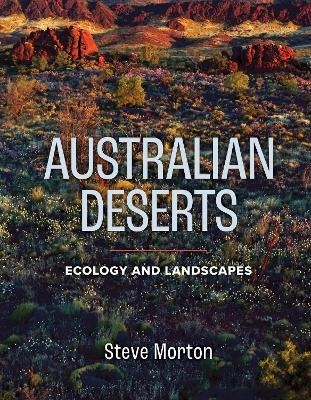
Australian Deserts
Ecology and Landscapes
Seiten
2022
CSIRO Publishing (Verlag)
978-1-4863-0599-5 (ISBN)
CSIRO Publishing (Verlag)
978-1-4863-0599-5 (ISBN)
Explores the vast sweep of the Outback, a land of expanses making up three-quarters of the continent - the heart of Australia. Steve Morton brings his extensive first-hand knowledge and experience of arid Australia to this book, explaining how Australian deserts work ecologically.
Australian Deserts: Ecology and Landscapes is about the vast sweep of the Outback, a land of expanses making up three-quarters of the continent – the heart of Australia. Steve Morton brings his extensive first-hand knowledge and experience of arid Australia to this book, explaining how Australian deserts work ecologically. This book outlines why unpredictable rainfall and paucity of soil nutrients underpin the nature of desert ecosystems, while also describing how plants and animals came to be desert dwellers through evolutionary time. It shows how plants use uncertain rainfall to provide for persistence of their populations, alongside outlines of the dominant animals of the deserts and explanations of the features that help them succeed in the face of aridity and uncertainty. Richly illustrated with the photographs of Mike Gillam, this fascinating and accessible book will enhance your understanding of the nature of arid Australia.
FEATURES:
Describes how Australian deserts work ecologically and how plants and animals came to be desert dwellers through evolutionary time.
Outlines two key features of arid Australia, uncertain rainfall and paucity of soil nutrients, that underpin the nature of its ecosystems.
Shows how plants use uncertain rainfall to provide for persistence of their populations.
Outlines the dominant animals of the deserts and explains the features that help them succeed in the face of aridity and uncertainty.
Features stunning images by renowned photographer Mike Gillam.
Australian Deserts: Ecology and Landscapes is about the vast sweep of the Outback, a land of expanses making up three-quarters of the continent – the heart of Australia. Steve Morton brings his extensive first-hand knowledge and experience of arid Australia to this book, explaining how Australian deserts work ecologically. This book outlines why unpredictable rainfall and paucity of soil nutrients underpin the nature of desert ecosystems, while also describing how plants and animals came to be desert dwellers through evolutionary time. It shows how plants use uncertain rainfall to provide for persistence of their populations, alongside outlines of the dominant animals of the deserts and explanations of the features that help them succeed in the face of aridity and uncertainty. Richly illustrated with the photographs of Mike Gillam, this fascinating and accessible book will enhance your understanding of the nature of arid Australia.
FEATURES:
Describes how Australian deserts work ecologically and how plants and animals came to be desert dwellers through evolutionary time.
Outlines two key features of arid Australia, uncertain rainfall and paucity of soil nutrients, that underpin the nature of its ecosystems.
Shows how plants use uncertain rainfall to provide for persistence of their populations.
Outlines the dominant animals of the deserts and explains the features that help them succeed in the face of aridity and uncertainty.
Features stunning images by renowned photographer Mike Gillam.
Dr Steve Morton is an Honorary Professorial Fellow with Charles Darwin University. He is an ecologist who studied at the Universities of Melbourne, California and Sydney. He joined CSIRO in Alice Springs in 1984 to work in the desert environment that has long been his focus. From 2000 until 2010, based in Canberra and Melbourne, he helped lead CSIRO as Chief of Division and Executive Team member.
Preface
1.Far horizons
2.Blue skies, occasional rain
3.Plant life
4.Harvesting plant life
5.Waste not
6.Invertebrate predators
7.Vertebrate predators
8.By the waterhole
9.Life in the Australian deserts
Glossary
Common and scientific names
Endnotes
Index
| Erscheinungsdatum | 21.03.2022 |
|---|---|
| Zusatzinfo | Illustrations |
| Verlagsort | Melbourne |
| Sprache | englisch |
| Maße | 210 x 270 mm |
| Gewicht | 1302 g |
| Themenwelt | Sachbuch/Ratgeber ► Natur / Technik ► Natur / Ökologie |
| Sachbuch/Ratgeber ► Natur / Technik ► Naturführer | |
| Naturwissenschaften ► Biologie ► Genetik / Molekularbiologie | |
| Naturwissenschaften ► Biologie ► Ökologie / Naturschutz | |
| Naturwissenschaften ► Biologie ► Zoologie | |
| Naturwissenschaften ► Geowissenschaften ► Geografie / Kartografie | |
| ISBN-10 | 1-4863-0599-7 / 1486305997 |
| ISBN-13 | 978-1-4863-0599-5 / 9781486305995 |
| Zustand | Neuware |
| Haben Sie eine Frage zum Produkt? |
Mehr entdecken
aus dem Bereich
aus dem Bereich
über 500 faszinierende Gesteine, Minerale, Edelsteine und Fossilien
Buch | Hardcover (2023)
DK Verlag Dorling Kindersley
CHF 39,90
Familien und Gattungen einheimischer Pflanzen
Buch | Hardcover (2022)
Haupt Verlag
CHF 67,95
Klimaschutz zerstört die Wirtschaft! ... und andere Stammtischparolen …
Buch | Softcover (2024)
Komplett-Media (Verlag)
CHF 33,55


